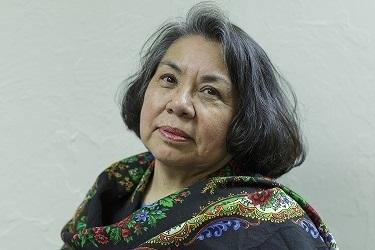
Credit: University of Oklahoma
OKLAHOMA CITY, OKLA. – The University of Oklahoma Health Sciences Center has been awarded a five-year, $38 million grant to lead and expand a national program dedicated to suicide prevention. The grant will be led by Dolores Subia BigFoot, Ph.D., a professor in the OU College of Medicine and a longtime researcher and organizer of suicide prevention efforts. Suicide prevention has always been a priority in the mental health community, but the new grant is especially timely as the nation faces increased stressors because of the COVID-19 pandemic and its economic toll, as well as racial injustice and inequality.
“We’re coming into this at a very important time,” BigFoot said. “We’re in a new era in which the suicide risk may increase. We want to increase our resources and grow a network of safety for people at risk of suicide.”
During the five-year grant, BigFoot and her team will be furthering the work of the Suicide Prevention Resource Center, an organization funded by the U.S. Substance Abuse and Mental Health Services Administration. More than 48,000 people in America died by suicide in 2018, according to the Centers for Disease Control and Prevention, and from 1999 through 2018, the suicide rate increased 35%. Suicide is complex and requires a multifaceted approach, but it is preventable, BigFoot said. Education, evidence-based prevention strategies and public awareness are among the tools to help people who are considering taking their own lives.
Among those at higher risk of suicide are people living in domestic violence situations, those who face poverty and persistent inequality in life, people who are elderly and people who live in rural communities. The LGBTQ+ community faces a higher risk, as do ethnic minorities such as American Indians and Alaskan Natives. First responders face an increased risk after working during major events like the Oklahoma City bombing and the terrorism of Sept. 11, 2001. And risk can be compounded by substance misuse or existing mental health conditions.
“By combining her medical knowledge and deep understanding of Native culture, Dr. Dee Bigfoot has expertly developed culturally responsive treatments to better serve Indigenous populations, who unfortunately face significant inequities in health care, including proper mental health support,” said OU President Joseph Harroz Jr. “This transformative grant will amplify the scope of her important work across tribes and other vulnerable groups, literally saving lives and preserving communities and cultures.”
Suicide is rarely something that people think about in the moment and complete, BigFoot said. “Suicide may be an individual act, but it is the final act of something that has led to that point,” she said. “We need to continue to understand the dynamics that come into play – trauma, substance misuse, mental illness, family conditions. People have such a burden of mental anguish that they perceive suicide as being the only way to stop the pain. We need to understand that everyone who is suicidal is struggling with something on a regular basis. It’s not there one day and gone tomorrow.”
BigFoot plans to address workforce development – training people in settings where they have regular opportunities to talk about suicide risk, such as clinics, hospitals, schools and colleges, and making suicide screening part of standard practice. People must become comfortable with asking someone if they’re thinking about harming themselves, and overcoming the myth that talking about suicide increases the chance that someone will carry it out, she said.
Suicide prevention also includes a specific focus on children, who are not immune from thinking about suicide as young as 4 or 5 years old, BigFoot said. Children may not be capable of carrying out suicide at a young age, but if they continue having thoughts of suicide as they get older, they are increasingly capable of completing the act. Prevention entails helping parents and intervening when children are facing neglect or harm.
Young people are also an asset when talking about suicide prevention, said Beverly Funderburk, Ph.D., an OU College of Medicine professor who is co-leading the grant with BigFoot.
“An important part of this effort is to incorporate the knowledge and voice of at-risk young people and have them be part of the solution,” Funderburk said. “For young people, it’s often much easier to talk about suicide risk when they hear about it from their peers.”
As an academic health system, the OU Health Sciences Center is well-positioned to lead this grant, Funderburk said. Both she and BigFoot are faculty members in the Center on Child Abuse and Neglect, a program within the College of Medicine’s Department of Pediatrics, Section of Developmental and Behavioral Pediatrics. BigFoot also directs the Indian Country Child Trauma Center. Together with their colleagues, they have a long history of clinical work, research, developing programs and training workforce. Along with partners across Oklahoma and the nation, they will use the grant to further the work of the Suicide Prevention Resource Center.
“Partnerships are a critical component of this program,” Funderburk said. “The grant allows us to bring our expertise and foundation in this area and collaborate with many partners across the nation, each of us bringing different strengths. Suicide absolutely can be prevented, and we want to address it as the public health concern that it is.”
Major partners on the grant include the American Psychiatric Association; Columbia University; the Education Development Center; Vibrant Emotional Health/National Suicide Prevention Lifeline; and the Southwest Prevention Center at University of Oklahoma Outreach.
This project is supported by the Substance Abuse and Mental Health Services Administration of the U.S. Department of Health and Human Services under the award number 1H79SM083028-01.
Editor’s note: View interview with Dr. BigFoot at https:/
###
OU Health Sciences Center
One of nation’s few academic health centers with seven professional colleges — Allied Health, Dentistry, Medicine, Nursing, Pharmacy, Public Health and Graduate Studies — the University of Oklahoma Health Sciences Center serves approximately 4,000 students in more than 70 undergraduate and graduate degree programs on campuses in Oklahoma City and Tulsa. For more information, visit ouhsc.edu.
About the University of Oklahoma
Founded in 1890, the University of Oklahoma is a public research university located in Norman, Oklahoma. OU serves the educational, cultural, economic and health care needs of the state, region and nation. For more information visit http://www.
About OU Medicine
OU Medicine — along with its academic partner, the University of Oklahoma Health Sciences Center — is the state’s only comprehensive academic health system of hospitals, clinics and centers of excellence. With 11,000 employees and more than 1,300 physicians and advanced practice providers, OU Medicine is home to Oklahoma’s largest physician network with a complete range of specialty care. OU Medicine serves Oklahoma and the region with the state’s only freestanding children’s hospital, the only National Cancer Institute-Designated Stephenson Cancer Center and Oklahoma’s flagship hospital, which serves as the state’s only Level 1 trauma center. OU Medicine is the No. 1 ranked hospital system in Oklahoma, and its oncology program at Stephenson Cancer Center and OU Medical Center ranked in the Top 50 in the nation, in the 2019-2020 rankings released by U.S. News & World Report. OU Medicine was also ranked by U.S. News & World Report as high performing in four specialties: Ophthalmology in partnership with Dean McGee Eye Institute, Colon Surgery, COPD and Congestive Heart Failure. OU Medicine’s mission is to lead healthcare in patient care, education and research. To learn more, visit oumedicine.com.
Media Contact
Kesha Keith
[email protected]
Original Source
https:/




